A terrarium is more than just a decorative piece—it’s a miniature living world that brings nature into your home. Imagine a lush, self-sustaining ecosystem thriving inside glass, needing little maintenance yet adding endless charm to your space. Creating a terrarium that lasts for years isn’t just about placing plants in a container—it’s about designing balance between soil, water, plants, and light.
This article will guide you through every step of building a long-lasting terrarium, from choosing the right materials and plants to ensuring its health and longevity.
1. What is a Terrarium?
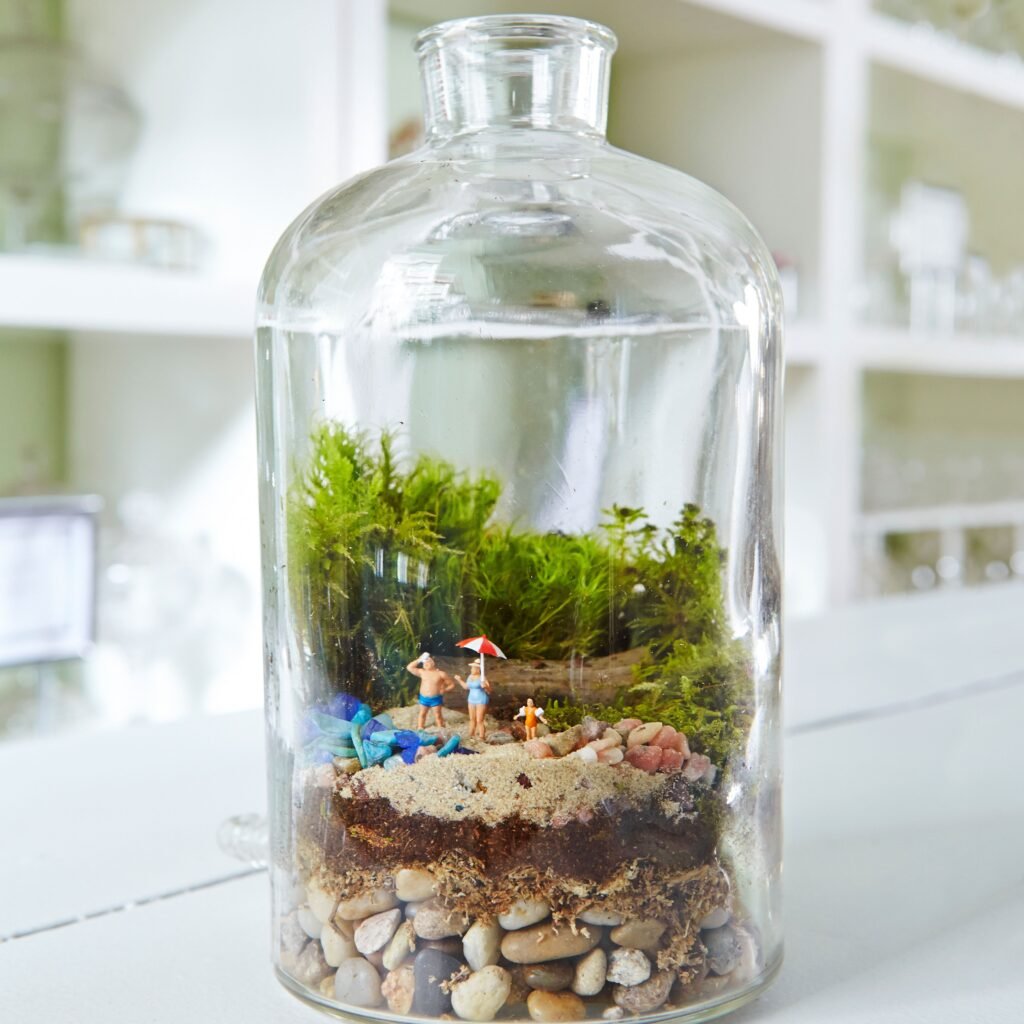
A terrarium is a small, enclosed or partially enclosed garden—usually made in a glass container—that houses plants and sometimes decorative elements like stones, moss, or miniature figurines.
There are two main types:
- Closed Terrariums: Sealed containers that recycle moisture, ideal for tropical or humidity-loving plants like ferns and mosses.
- Open Terrariums: Containers with wide openings that allow airflow, suitable for cacti, succulents, and air plants.
Both types can last for years when built and maintained properly. Some closed terrariums have even survived for decades—creating their own mini-ecosystems.
2. Why Build a Long-Lasting Terrarium?
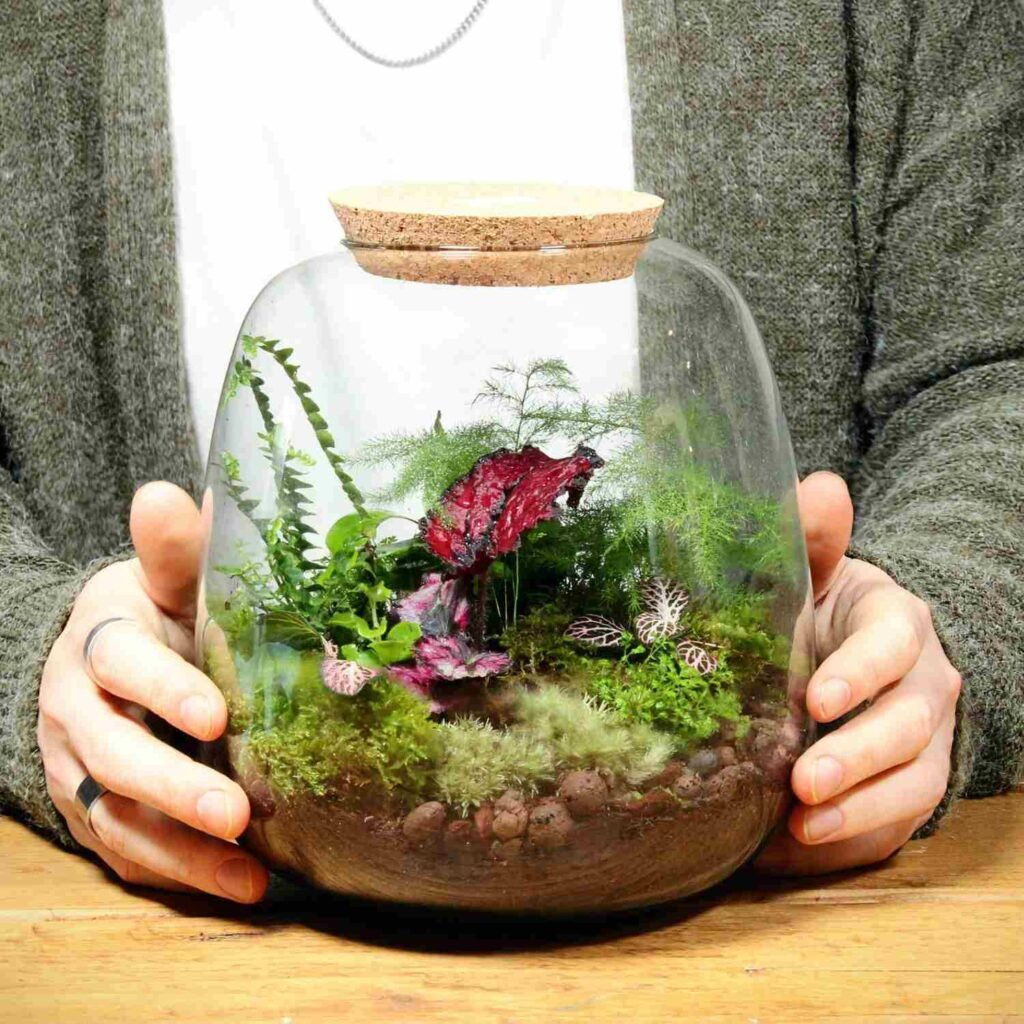
A long-living terrarium offers both aesthetic and practical benefits:
- Low Maintenance: Once balanced, it needs minimal watering or pruning.
- Eco-Friendly Décor: Made with recycled glass containers and living plants.
- Educational: Demonstrates natural cycles like condensation and photosynthesis.
- Therapeutic: Watching your terrarium thrive reduces stress and boosts mood.
- Longevity: A well-constructed terrarium can last 5 to 10 years or more with care.
Creating one that lasts means focusing on balance—right materials, correct layering, suitable plants, and controlled conditions.
3. Materials You’ll Need
To make a terrarium that lasts, start with quality materials that promote drainage, prevent mold, and sustain healthy growth.
Essential Materials:
- Glass container: Choose a jar, bowl, or aquarium (clear and clean).
- Pebbles or gravel: For drainage and root aeration.
- Activated charcoal: Prevents odor, mold, and bacterial buildup.
- Moss (optional): Acts as a barrier to keep soil from mixing into gravel.
- Potting soil: Choose based on your plant type (succulent mix for cacti, rich organic mix for ferns).
- Plants: Slow-growing species suited for terrarium life.
- Decorations: Stones, figurines, or shells (optional).
- Spray bottle: For misting and watering.
Tip: Use sterile, chemical-free materials to prevent unwanted mold or pests from forming inside.
4. Choosing the Right Container
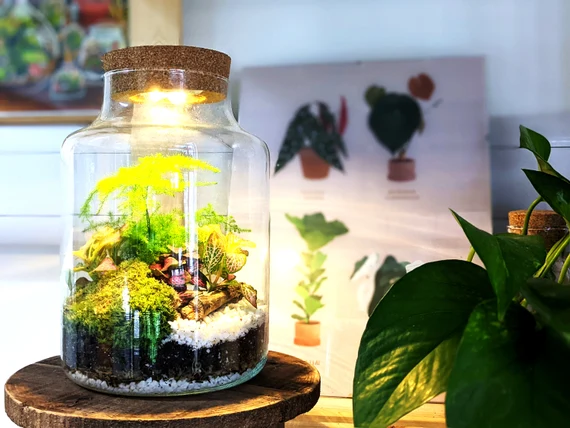
Your container plays a key role in determining the microclimate of your terrarium.
Closed Terrarium (for humidity-loving plants):
- Examples: Glass jars with lids, large bottles, or bell jars.
- Ideal for: Ferns, moss, ivy, fittonia, and small tropical plants.
- Advantage: Self-watering and visually captivating.
Open Terrarium (for dry plants):
- Examples: Bowls, fish tanks, or geometric glass planters.
- Ideal for: Succulents, air plants, and cacti.
- Advantage: Prevents mold and rot due to airflow.
Pro tip: Avoid containers that are too small—plants need breathing room for roots and air circulation.
5. Selecting the Right Plants
The secret to a long-lasting terrarium lies in choosing slow-growing, hardy plants that thrive in low to moderate light.
For Closed Terrariums:
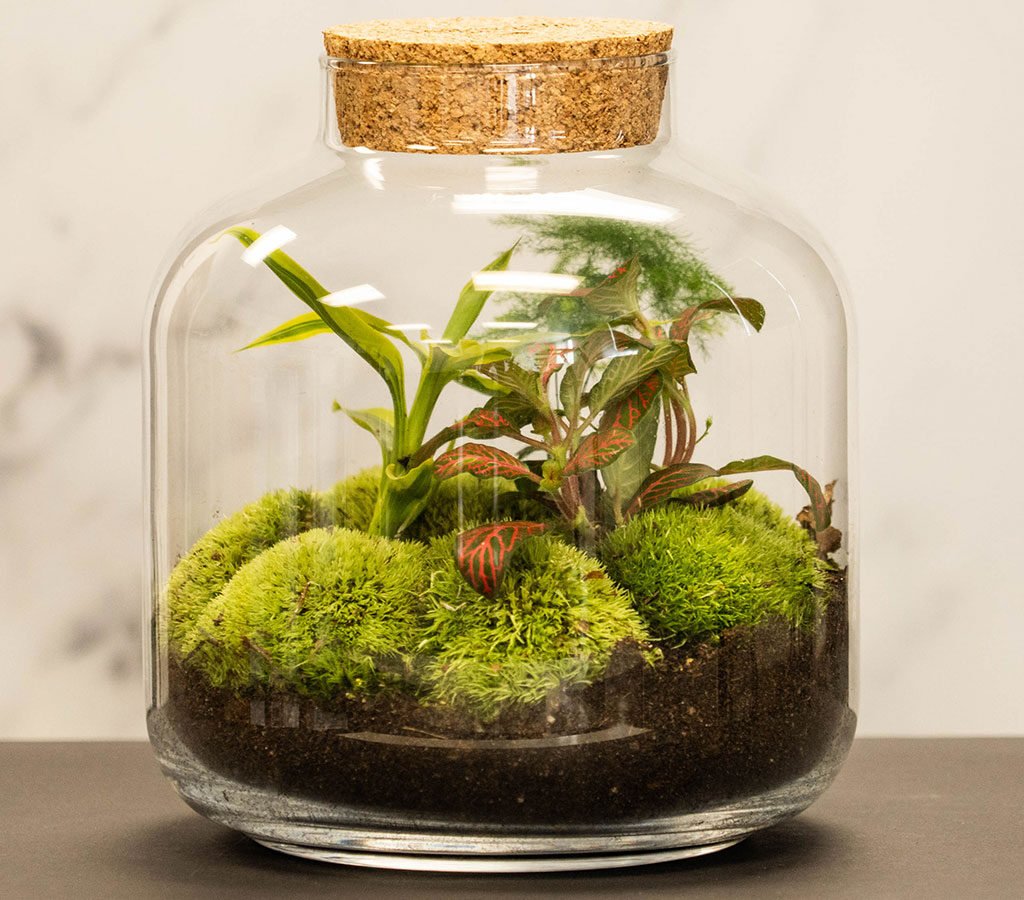
- Ferns (Asparagus, Maidenhair, Button fern)
- Moss (Sheet or Cushion moss)
- Fittonia (Nerve Plant)
- Pilea
- Peperomia
- Miniature ivy
For Open Terrariums:
- Echeveria
- Haworthia
- Sedum
- Aloe (small varieties)
- Air Plants (Tillandsia)
Avoid plants that grow too quickly or require frequent pruning, as they will disrupt the balance over time.
6. Step-by-Step: How to Build a Long-Lasting Terrarium
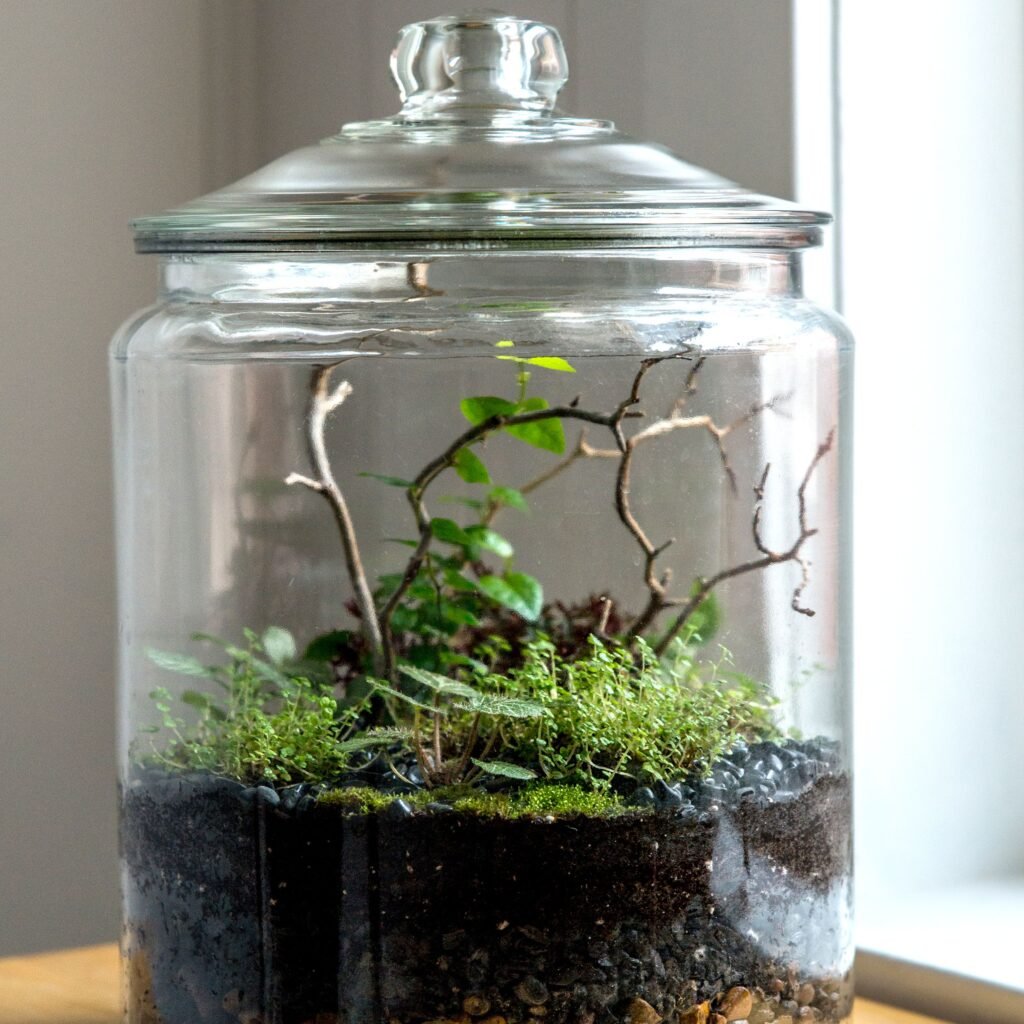
Step 1: Clean the Container
Wash the container thoroughly with warm, soapy water and dry completely. Any residue can lead to mold or bacterial growth later.
Step 2: Create the Drainage Layer
Add a 1–2 inch layer of pebbles or small gravel at the bottom. This prevents roots from sitting in stagnant water, reducing the risk of rot.
Step 3: Add Activated Charcoal
Sprinkle a thin layer (about half an inch) of activated charcoal over the gravel. It absorbs odors and toxins, keeping the environment clean.
Step 4: Insert Moss (Optional but Recommended)
Place a thin layer of sheet moss over the charcoal. It acts as a barrier that stops soil from filtering down into the gravel, preserving your terrarium’s layers.
Step 5: Add Potting Soil
Add enough soil for your plants to take root—typically 2–3 inches deep.
- For ferns and tropicals: Use rich, well-draining potting mix.
- For succulents: Use cactus mix or blend potting soil with sand and perlite.
Step 6: Plant Carefully
Create small holes in the soil and insert each plant gently. Arrange taller plants in the back and smaller ones toward the front for visual balance. Compact the soil lightly to secure roots.
Step 7: Add Decorative Touches
Enhance beauty with mini stones, driftwood, moss patches, or figurines. Avoid overcrowding; leave space for plant growth and airflow.
Step 8: Water Sparingly
Use a spray bottle to lightly mist the plants. Do not soak the soil—especially for closed terrariums, where water recycles naturally.
Step 9: Seal or Leave Open
- Close the lid for a humid, self-sustaining environment.
- Leave open for air-loving species like succulents.
After setup, place the terrarium in indirect light and allow it to settle for a week.
7. Light and Placement
Light is essential, but direct sunlight can cause heat buildup and condensation, harming the plants.
Lighting Tips:
- Indirect or filtered light is best for most terrariums.
- Place near a north- or east-facing window.
- For low-light areas, use LED grow lights for a few hours daily.
- Avoid hot window sills or areas with strong afternoon sunlight—it can “cook” your terrarium.
Stable light ensures even plant growth and prevents moss or roots from drying out.
8. Watering and Humidity Control
Terrariums create their own water cycle—moisture evaporates, condenses on glass, and drips back down.
However, overwatering is the most common reason terrariums fail.
Closed Terrariums:
- Water sparingly, just once every 4–6 weeks.
- If condensation forms heavily, open the lid for a few hours to let excess moisture escape.
- If soil looks dry and condensation disappears, mist lightly.
Open Terrariums:
- Water more often, about once a week for succulents or when soil feels dry.
- Avoid water pooling at the bottom.
Tip: Always use a spray bottle or dropper for better control.
9. Long-Term Maintenance
To ensure your terrarium lasts for years, consistent but minimal care is key.
- Prune regularly: Trim dead leaves and overgrown stems.
- Clean the glass: Wipe off condensation or algae buildup with a soft cloth.
- Rotate periodically: Turn the terrarium occasionally to ensure even light exposure.
- Replace or refresh soil every few years to renew nutrients.
- Watch for pests: If you notice fungus gnats or mold, open the lid and let it dry for a few days.
10. Common Problems and How to Fix Them
| Problem | Cause | Solution |
|---|---|---|
| Mold growth | Too much humidity, poor air circulation | Open lid occasionally, add more charcoal. |
| Yellow leaves | Overwatering or lack of light | Reduce watering, move to brighter spot. |
| Wilting plants | Root rot or underwatering | Adjust watering, check soil layers. |
| Foggy glass | Excess condensation | Remove lid temporarily to balance humidity. |
| Algae buildup | Excess light and moisture | Clean glass gently, reduce watering. |
Maintaining balance is the secret—observe your terrarium regularly, but avoid frequent interference.
11. How to Help Your Terrarium Thrive for Years
A terrarium that lasts for years mimics nature’s balance. Here are some expert tips:
- Choose slow-growing plants that won’t outgrow their space.
- Avoid fertilizers—they encourage rapid growth that can crowd the container.
- Maintain airflow by opening closed terrariums occasionally.
- Monitor condensation—it’s a sign of proper humidity but should not be excessive.
- Add moss—it helps stabilize humidity and keeps the terrarium visually lush.
- Refresh periodically—remove dying plants or replace topsoil if needed.
With this steady balance, your terrarium can truly become a miniature world that thrives for many years.
12. Decorating Ideas for Long-Lasting Beauty
- Layered landscapes: Create mountain or valley-like effects using soil mounds.
- Mini ecosystems: Mix moss, stones, and ferns for a forest floor look.
- Fantasy terrariums: Add tiny houses, fairies, or pathways for charm.
- Zen terrariums: Use sand, pebbles, and air plants for a minimalist look.
Designing your terrarium as a visual story ensures it stays interesting even as plants mature.
Conclusion
Making a terrarium that lasts for years is about crafting balance and harmony between all its elements—light, moisture, soil, and plant life. With the right setup and minimal care, your terrarium will become a living piece of art that keeps evolving and thriving with time.
Whether you choose a lush, humid jungle in a jar or a sunny, open desert landscape, your terrarium can remind you of nature’s resilience and beauty—right on your tabletop.
So gather your glass jars, a few pebbles, and some green friends, and start creating your own long-lasting miniature ecosystem—a timeless reminder that even the smallest worlds can flourish beautifully when balanced with care.
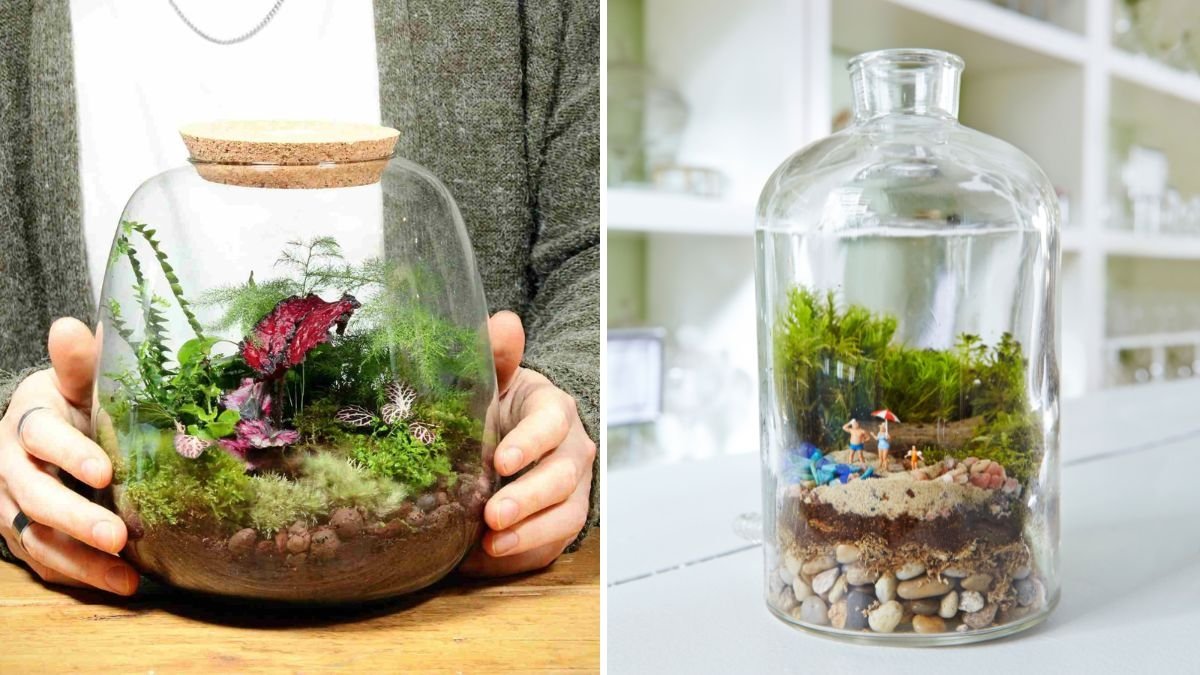




Leave A Comment